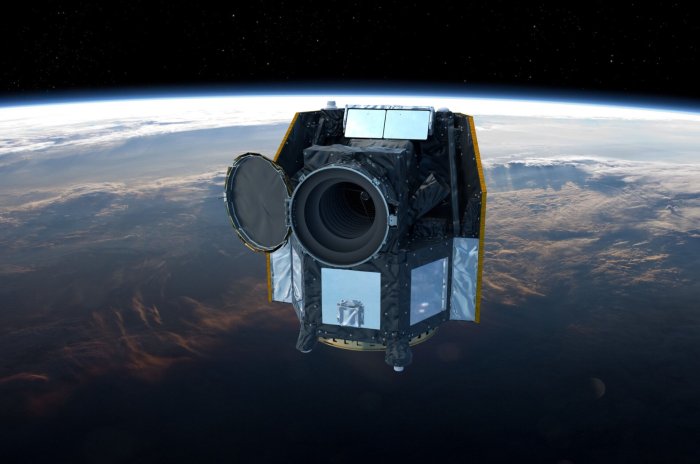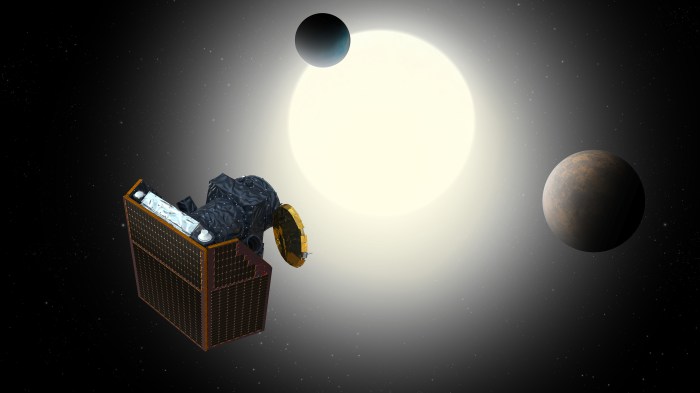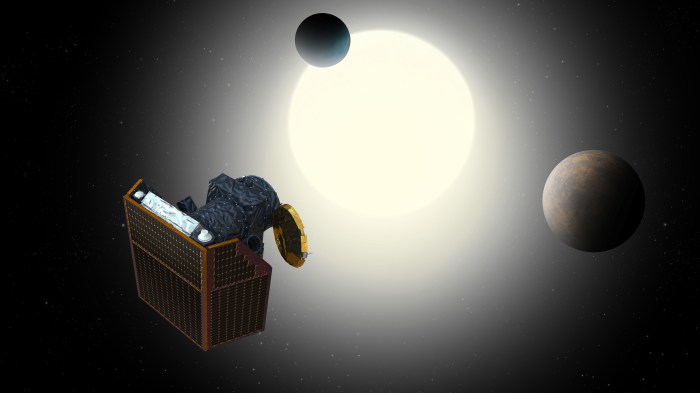ESA Cheops spacecraft discovers star system, a monumental achievement in the field of exoplanet research. This discovery, made by the Cheops spacecraft, a dedicated exoplanet characterization mission, marks a significant leap forward in our understanding of planetary systems beyond our own.
Cheops, a telescope designed to observe transiting exoplanets, has been diligently studying these distant worlds, meticulously measuring their sizes and orbital periods.
The transit method, employed by Cheops, involves observing the slight dimming of a star’s light as an exoplanet passes in front of it. By analyzing these dips in brightness, scientists can deduce the size and orbital characteristics of the exoplanet.
Cheops’s exceptional precision and sensitivity allow for detailed characterization of these distant worlds, providing valuable insights into their compositions and atmospheres.
ESA Cheops Spacecraft Mission Overview

The Characterising Exoplanet Satellite (CHEOPS) is a European Space Agency (ESA) mission designed to study exoplanets, planets orbiting stars other than our Sun. Its primary goal is to precisely measure the sizes of known exoplanets by observing the tiny dips in starlight that occur when a planet passes in front of its host star, an event known as a transit.
Scientific Objectives
The CHEOPS mission aims to address key questions about exoplanet characteristics and formation:
- Determine the precise sizes of known exoplanets, particularly those in the “habitable zone,” the region around a star where liquid water could exist on a planet’s surface.
- Characterize the atmospheres of exoplanets, searching for signs of water vapor, methane, and other gases that could indicate the presence of life.
- Investigate the diversity of exoplanet systems, including their orbital configurations and the types of stars they orbit.
- Refine our understanding of the processes that lead to the formation and evolution of planetary systems.
Role of CHEOPS in Exoplanet Studies
CHEOPS plays a crucial role in exoplanet research by providing precise measurements of exoplanet sizes. These measurements are essential for understanding the physical properties of exoplanets, such as their density and composition. By combining these measurements with data from other telescopes, scientists can gain a more comprehensive understanding of the nature of exoplanets and their potential for hosting life.
CHEOPS Telescope Features and Capabilities
The CHEOPS spacecraft is equipped with a 30-centimeter telescope optimized for observing transits of exoplanets. Key features and capabilities include:
- High photometric precision, enabling the detection of tiny changes in starlight during a transit.
- A wide field of view, allowing CHEOPS to observe a large number of exoplanet systems.
- A long-duration observing capability, enabling the spacecraft to monitor exoplanets for extended periods.
Mission Details, Esa cheops spacecraft discovers star system
- Launch Date: December 18, 2019
- Orbit: Sun-synchronous orbit, at an altitude of approximately 800 kilometers.
- Mission Duration: At least 3.5 years, with the potential for extension.
Exoplanet Discovery and Characterization: Esa Cheops Spacecraft Discovers Star System

Cheops, the Characterizing Exoplanet Satellite, is a space telescope designed to precisely measure the sizes of known exoplanets. It achieves this by observing the slight dimming of a star’s light as an exoplanet passes in front of it, a phenomenon known as a transit.
This data, combined with information about the star’s properties, allows scientists to determine the exoplanet’s size and density.
Transit Method
The transit method is the primary technique used by Cheops to detect and characterize exoplanets. This method relies on the principle that when an exoplanet passes in front of its host star, from our perspective, it blocks a tiny portion of the star’s light, causing a slight dip in the star’s brightness.
The duration and depth of this dip provide crucial information about the exoplanet’s size and orbital period.
The depth of the transit is proportional to the ratio of the planet’s area to the star’s area.
Cheops observes these transits with high precision, allowing astronomers to determine the exoplanet’s radius with an accuracy of up to 1%. This precision is crucial for understanding the composition and structure of exoplanets.
Significance of Cheops’s Observations
Cheops’s observations have significantly advanced our understanding of exoplanet atmospheres and compositions. By measuring the size of exoplanets with unprecedented accuracy, scientists can combine this information with other data, such as the exoplanet’s mass, to determine its density. This density provides insights into the exoplanet’s internal structure and composition, helping to distinguish between rocky, gaseous, or water-rich planets.For example, Cheops’s observations of the exoplanet WASP-189b revealed that this planet is a hot Jupiter with a very low density, suggesting that it is inflated and has a very extended atmosphere.
Examples of Exoplanet Systems Discovered or Studied by Cheops
Cheops has played a crucial role in studying numerous exoplanet systems, contributing to our understanding of the diversity of planets beyond our solar system. Here are a few notable examples:
- WASP-189b: This hot Jupiter, orbiting a star about 322 light-years away, is one of the hottest exoplanets ever discovered. Cheops’s observations revealed that WASP-189b has a very low density, indicating that it is inflated and has a very extended atmosphere.
This information provides valuable insights into the atmospheric conditions of hot Jupiters.
- 55 Cancri e: This super-Earth, located about 40 light-years away, is one of the most massive exoplanets known. Cheops’s observations helped refine the planet’s size and density, revealing that it is likely a rocky planet with a dense iron core. This information helps us understand the diversity of rocky planets beyond our solar system.
- GJ 367b: This ultra-hot Earth, located about 31 light-years away, is one of the smallest exoplanets discovered to date. Cheops’s observations helped confirm its size and density, revealing that it is a dense, rocky planet. This information provides valuable insights into the formation and evolution of small, rocky planets.
Check what professionals state about worlds most powerful laser uk and its benefits for the industry.





